Muthiah Velaiya meticulously documented wedding invitations that he received from 1943. The cards, most of which are invites to marriages in the Thondaimandala Mudaliar community, also tell the story of literacy and politics in the state.
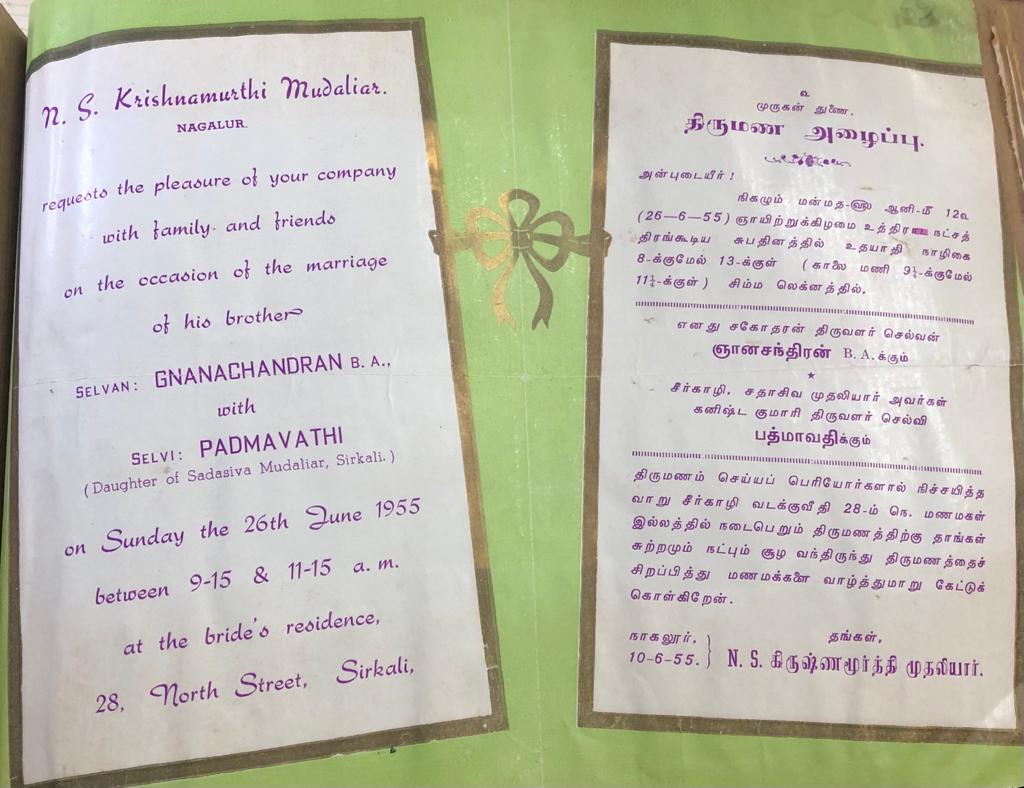
A wedding card from the first volume of Muthiah Velaiya's collection (Velaiya Karthikeyan)
Muthiah Velaiya was just 20 in 1943 when he received his first invite to a wedding. After the event got over, he decided to save the card — a novelty in those times.
It was the time of World War II and there was a crippling paper shortage. But some families, conscious of their status, still insisted on printing wedding invitations.
This wedding card in Tamil, in red and green fonts on a white ordinary paper, was sent by a Thiyagarajan for his daughter’s marriage scheduled on 9 July 1943 at a residence in Tiruvarur — then in Madras Presidency, now Tamil Nadu.
The next wedding to which Velaiya got an invite, this time in both Tamil and English, took place on 13 September 1944 in Therazhundur — the birthplace of the great poet Kambar. This was a year before Velaiya himself married.
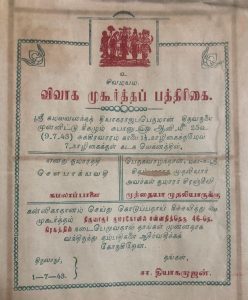
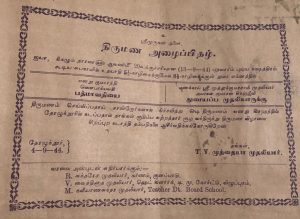
His Chennai-based son Velaiya Karthikeyan, a retired Central government officer, proudly shows the cards arranged neatly in four cardboard-bound albums that cover the years 1943 to 1991. The remaining cards are kept loose.
“This is not just a unique collection but these cards tell the story of literacy and politics in Tamil Nadu as they evolved over time,” Karthikeyan said in a telephonic interview. “I don’t know of anyone else who has such a collection.”
Velaiya, who married at age 22, worked his whole life for the Railway Mail Service (RMS), which has since been abolished. Most of the wedding invitations he got in early adulthood were from the Thondaimandala Mudaliar community, to which he belonged. Almost all the cards in the collection involve marriages of those belonging to the same community.
For a long time, the mass of Indians — as opposed to the royalty — invited one another to weddings and other social events by word of mouth. Under British influence, it became fashionable to print invitations.
But those going for printing needed to have money to spend and also be part of a fairly educated community for people to read and appreciate the invitations.
Most wedding cards Velaiya collected in the initial years were exclusively in Tamil. Curiously, it was only after India’s Independence in 1947 that English also came to be used regularly along with Tamil.
The graduation to bilingual invitations clearly accompanied rising levels of literacy. To start with, even Tamil-English invitations were on a single page before families started opting for cards where the two languages were printed either back-to-back or parallel to one another.
Keeping in mind both the paper shortage and the money one could afford to pay, it took some years for one-page simple invitations to evolve into foldable, double-page documents in the 1950s and 60s before it became a norm.
The preferred venues for marriages in the 1940 and 50s were the houses of the bride or nearby temples, with the girl’s family footing the bill.
The wedding halls began sprouting, the card collection reveals, in urban areas in the 1960s as the number of invitees began to slowly climb.
Significantly, all invitations initially used Sanskrit expressions with Brahminical overtones, calling the bride “Sowbhagyawati” and the groom “Chiranjeevi” and also listing the auspicious “Muhurtham” time when the most important ritual would be performed.
Once the Dravidian ideology began to take root, a section of the families began to use pure Tamil — devoid of Sanskrit expressions — and even do away with Brahmin priests.
This also led to the disappearance, but not fully, of the miniature pictures of Hindu gods and religious appeals such as “Murugan Thunai”, “Sivamayam”, and “Sri Rama Jayam” from the cards.
This development was most pronounced in the late 1960s — the DMK took power in Tamil Nadu for the first time in 1967 — and 1970s. This was when families began to ask DMK stalwarts to preside over the weddings.
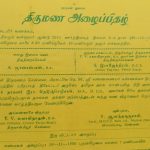
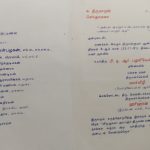
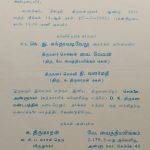
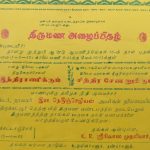
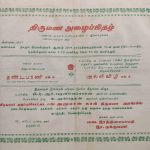
With the advent of modern printing technology, people began using double colour paper in wedding cards — yellow for Tamil printing (yellow was seen as auspicious) and a rosy backside for English printing. This tradition is still in vogue.
The first of four volumes of invitations collected by Velaiya covered the 1943–1968 period, followed by 1968–1978, 1978–1985, and 1985–1991. The invites that came later (till 2000) remain in a cardboard box, which occupies a place in an attic at Karthikeyan’s middle-class house.
“Each time a wedding took place, my father would meticulously paste it in a register,” Karthikeyan recalled. “He kept a ruler, a scissor, brown paper, glue and a stapler with him. He loved the collection, and soon all of us fell in love with it.”
He added: “But I did not realise the significance of the collection the first few times I went through them. It is much later it dawned on me how much one could learn about Tamil society from these invitations.”
So why did Velaiya stop the collection?
“Interestingly, that happened when he realised that the size of my daughter’s — his granddaughter’s— wedding invitation was too big for his register. He didn’t say anything, but he just put a full stop to his hobby.”
Vellaiya may not have realised it but he has left behind a mirror to Tamil society. “The collection is a treasure,” says Karthikeyan.
(MR Narayan Swamy is a freelance journalist in New Delhi. He began his career more than four decades ago. He had a long innings in UNI, AFP, and IANS. His focus areas are diplomacy, politics, and spirituality, and he loves to read and review books. He is the author of three books on the Sri Lankan conflict)

Apr 25, 2024

Apr 25, 2024

Apr 25, 2024

Apr 25, 2024

Apr 25, 2024

Apr 25, 2024